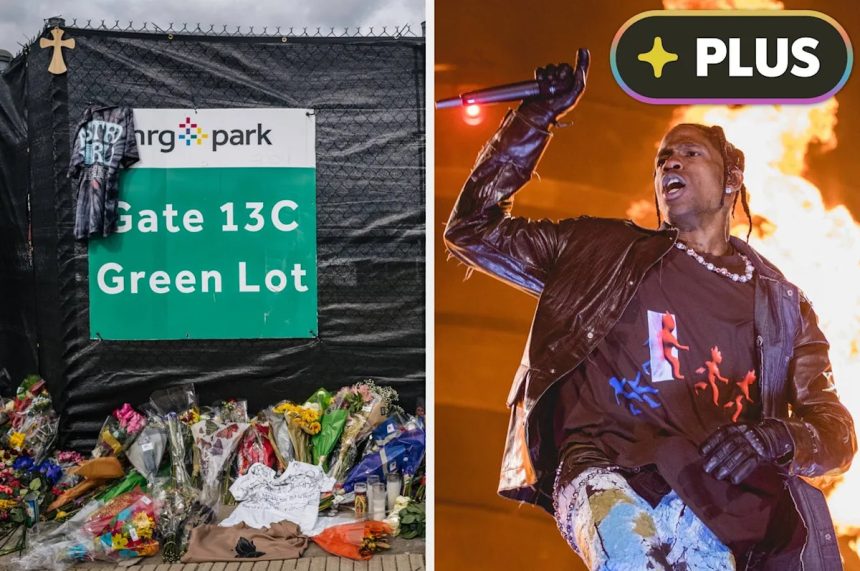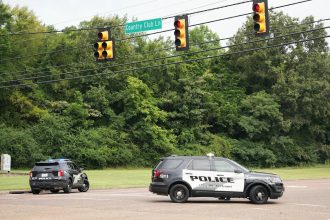Across centuries and continents, dense human gatherings have ended in sudden, suffocating tragedy — not simply from “panic,” but from physics and planning failure. While panic can sometimes trigger the initial surge, it is the underlying design flaws and physics that cause the lethal compression. When space runs out and pressure builds, crowds behave like fluid: a single obstacle or counterflow can turn motion into catastrophe. From pilgrimages to music festivals, these 14 events reveal how systemic errors, not human chaos, keep repeating:
1. The Itaewon Halloween Crush (2022, Seoul, South Korea)
Nurphoto / Getty Images
On October 29, 2022, the popular Seoul nightlife district of Itaewon, known for its narrow, winding streets, transformed from a site of a Halloween celebration into a sudden, devastating tragedy. An estimated 100,000 people poured into the streets, leading to an unprecedented crowd crush in a narrow, sloping alleyway measuring just 3.2 meters (10.5 feet) wide. The crush killed 159 people and injured 196 others, making it the worst peacetime disaster in South Korea since the 2014 Sewol ferry sinking. The surge built and collapsed within minutes, transforming a casual night out into a mass casualty event.
What makes the Itaewon crush particularly heartbreaking is the demographic of the victims: most were in their teens and 20s, predominantly young women, many in costumes. The surge began as people attempted to move both up and down the alley simultaneously, creating a crushing, immovable pile-up. Forensic evidence later confirmed that the cause of death for nearly all victims was compressive asphyxiation — they were squeezed so tightly their lungs could not expand, unable to breathe.
Investigations revealed multiple factors contributing to the tragedy. While an illegal wall extension by the adjacent Hamilton Hotel was investigated and an injunction issued for its removal, the alley was inherently narrow (3.2 meters wide) to begin with. The governmental investigation centered primarily on the lack of proactive crowd control by police and city officials despite anticipating a large turnout. The tragedy remains a haunting symbol of how quickly a fun, modern gathering can descend into primal, confined terror, leaving behind painful questions about planning and governmental accountability for spontaneous events.
2. 2010 Love Parade Disaster (Duisburg, Germany)

Picture Alliance / Getty Images
The Love Parade in Duisburg, Germany, on July 24, 2010, became a chilling modern case study in flow management failure. The massive electronic music festival was held on a former freight yard, accessible primarily through a single, narrow tunnel. As attendance swelled far beyond the planned capacity, authorities tried to regulate movement by blocking the tunnel’s ends — an intervention that instead created a deadly bottleneck.
Caught between the incoming masses and those already trapped inside, thousands were compressed on a ramp leading up to the festival grounds. Twenty-one people were killed and more than 650 were injured. Subsequent investigations revealed severe structural and planning flaws, including the decision to funnel all foot traffic through one confined access point.
The tragedy is now internationally recognized as a textbook example of crowd-control failure and is frequently cited in safety training manuals. It demonstrated with brutal clarity how channeling large numbers of people through a single, inflexible point of entry can turn even a well-intentioned event into a preventable catastrophe.
3. The 1943 Bethnal Green Tube Disaster (London, England)

Vickie Flores / Getty Images
On March 3, 1943, during World War II, residents of East London rushed to the Bethnal Green Tube station to seek shelter after an air-raid warning siren sounded. The chilling reality of this disaster is that no bombs fell that night; the mass casualty event was a result of fear, poor design, and the fatal mechanics of a crowd collapse.
The crush began when a woman carrying a child tripped on the third step from the bottom of the main unlit staircase. The cascade was instantaneous: the massive crowd pushing from the top, unable to see the blockage due to the blackout, piled up. Within minutes, the cumulative pressure against the solid concrete stairs and walls resulted in a pure compressive failure.
The disaster killed 173 people, of whom 84 were children (under age 16) and 62 were women. A later inquiry determined that the lack of a central handrail was a critical flaw. This tragedy fundamentally shaped modern crowd science, forcing authorities to recognize that panic, combined with a single point of entry and poor infrastructure, can be as deadly as any external threat.
4. Astroworld Festival Disaster (2021, Houston, USA)

Brandon Bell / Getty Images
On the night of November 5, 2021, during the Astroworld music festival headlined by rapper Travis Scott, an estimated 50,000 attendees compressed into the standing area, leading to a fatal crowd surge. The crush began violently as the crowd surged forward toward the stage, pushing festival-goers so tightly together that they couldn’t control their own movements. Ten people were killed, with the youngest victim being 9 years old (Ezra Blount) and all other victims ranging between the ages of 14 and 27. The initial death count was eight, with two others dying later from their injuries, bringing the total to ten. Hundreds were injured.
The terrifying detail of Astroworld is its digital-era visibility: thousands of phones were filming as the deadly density was reached, yet the show continued for nearly an hour after authorities declared a mass casualty incident. Victims who succumbed were found to have died of compressive asphyxiation, with analysis showing that density in the most lethal pockets of the crowd reached a point where the mass literally collapses on itself.
Astroworld exposed profound gaps in modern event command structure, showing that communication between performers, security, and medical staff failed to stop the concert even as the emergency became visually clear. This incident showed that the joyful, communal energy of a concert can tragically transform into a mass disaster, challenging the notion that technology and planning can always overcome the basic physics of human pressure.
5. 1964 Estadio Nacional Disaster (Lima, Peru)

Daniel Apuy / Getty Images
The single deadliest sports crowd disaster in history occurred on May 24, 1964, during an Olympic qualifier match in Lima. Riots broke out after a late goal for Peru was disallowed. Police reacted with devastating force, firing tear gas canisters into the densely packed crowd, triggering a massive, panicked surge toward the exits.
The tragedy was sealed by a catastrophic design flaw: the main exit gates leading out of the descending tunnels were locked and sealed. Trapped inside the narrow, inclined passages, crowds were compressed and suffocated as people streamed in from above. A total of 328 people were killed, with over 500 injured.
For decades, the event was framed solely as a narrative of “panic” and rioting, but later analysis correctly identified the core issue as design flaws and police mismanagement. The lethal combination of chemical irritants in a confined space and the inability to escape turned a simple football match into a massacre, prompting worldwide scrutiny of stadium safety.
6. 1971 Ibrox Stadium Disaster (Glasgow, Scotland)

Mirrorpix / Getty Images
On January 2, 1971, following a thrilling “Old Firm” match between Rangers and Celtic, tragedy struck on Stairway 13 at Ibrox Stadium. Thousands of fans were attempting to exit the stadium when a sudden surge—either caused by an isolated fall or simply the immense pressure of the tightly packed mass—caused people to fall near the bottom.
The weight of the bodies tumbling from above quickly created a fatal, unyielding block of bodies in the narrow stairwell. The disaster killed 66 fans and injured over 200. Many victims were young men and boys who died of compressive asphyxiation near the point of exit.
This event served as a critical, early British reform precedent that led to sweeping new safety legislation, particularly the conversion of standing terraces into seating and major overhauls of stadium egress designs to prevent such confined bottlenecks. The tragic deaths prompted the recognition that older stadium designs were incompatible with modern crowd numbers.
7. 1989 Hillsborough Disaster (Sheffield, England)

Derek Hudson / Getty Images
The Hillsborough disaster of April 15, 1989, remains a profound tragedy and a watershed moment in UK justice history. Ninety-seven Liverpool fans were killed after police opened an exit gate, funneling thousands of fans into two already-full and fenced standing pens behind a goal. Trapped against high perimeter fences, fans were compressed to death in a lethal human wall. The initial death toll was 95, with a 96th victim dying four years later in 1993 without emerging from a coma, and the 97th victim (Andrew Devine) dying in 2021 from injuries sustained in the crush.
The core of this disaster was systemic failure and police mismanagement. Subsequent official inquiries cleared the fans and confirmed that the victims were unlawfully killed due to severe negligence, directly contradicting the media’s initial attempts to scapegoat supporters.
The Hillsborough disaster remains a profoundly important lesson on the dangers of perimeter fencing, undersized standing sections, and inadequate emergency response. The tragedy led to the Taylor Report, which banned standing terraces at major UK stadiums, creating the all-seater standard that has since prevented similar tragedies.
Related: “It Was Really Toxic”: People Are Revealing The ’00s Trends That Were Genuinely Awful Looking Back
8. 1990 Mecca Tunnel Tragedy (Saudi Arabia)

Anadolu / Getty Images
The Al-Ma’aisim Tunnel disaster on July 2, 1990, during the Hajj pilgrimage, remains one of the most horrific crowd tragedies in history. A sudden blockage occurred inside the 500-meter pedestrian tunnel leading to Mecca’s holy sites, where thousands of pilgrims were attempting to pass through. The relentless pressure from the masses entering the tunnel continued from behind, turning the enclosed space into a death chamber.
The angle here is terrifying: massive density plus enclosed space equals total pressure collapse. Trapped in searing heat, the vast majority of the 1,426 pilgrims were crushed or suffocated to death, becoming a solid, unmoving mass.
This disaster is a stark illustration of how poor exit design — and the absence of real-time communication — can turn a moment of confusion into a mass-casualty event on the scale of a natural disaster. The tragedy served as a critical alarm, prompting large-scale redesigns of Hajj infrastructure to prioritize open space, clear routing, and effective flow-control management. It remains a grim reminder of how fragile safety becomes when millions move through confined space at once.
9. 2005 Baghdad Bridge Disaster (Iraq)

Karim Sahib / Getty Images
On August 31, 2005, during a massive Shi’a pilgrimage in Baghdad, rumors of a suicide bomber swept through the densely packed crowd crossing the Al-A’immah Bridge. The sudden wave of fear triggered a panicked surge toward the far side of the bridge, where a closed gate created a deadly bottleneck.
Trapped between the advancing crowd and the locked exit, thousands were crushed against the gate or forced over the sides into the Tigris River. Many of the 953 people who died drowned after being pushed or jumping into the water to escape, while others succumbed to compressive asphyxiation on the bridge itself. Nearly 800 more were injured.
This disaster is a stark illustration of how misinformation, combined with poor exit design, can turn fear into catastrophe. The tragedy exposed how a single point of failure — one blocked path — can transform a moment of confusion into one of the deadliest mass-casualty incidents in modern history.
10. 2015 Mina Disaster (Saudi Arabia)

Mohammed Al-shaikh / Getty Images
Despite decades of safety reforms, the Hajj pilgrimage was the site of the most fatal crush in modern recorded history on September 24, 2015. The tragedy occurred when two vast streams of pilgrims moving in opposite directions intersected on Street 204 near the Jamarat Bridge, creating two counterflows that spiraled into a devastating, uncontrollable crush.
The official death toll was 769, but subsequent analysis of reports from over 30 countries suggested a final count of well over 2,000 killed, a record-breaking scale that highlights the extreme difficulty of logistics management at such a huge human gathering.
The crush quickly overwhelmed emergency services. This event, despite all prior lessons, demonstrated a severe human logistics failure, proving that even with advanced infrastructure, the physics of immense crowd density combined with conflicting flows can be unforgiving and lead to a monumental disaster.
11. 2024 Hathras Satsang Disaster (India)

Ritesh Shukla / Getty Images
On July 2, 2024, during a religious gathering for the guru Bhole Baba in Hathras, India, a sudden collapse and crush killed 121 people and injured more than 150. The tragedy occurred as devotees, leaving the event, were channeled into an unavoidable bottleneck near the exit of the gathering grounds.
The disaster quickly turned into a terrifying crush and pile-up as the overwhelming crowd, estimated far above the official capacity, pressed forward to leave. The sudden fall of some individuals created a lethal pile-up on the ground, where the vast majority of the deaths occurred due to asphyxiation.
This incident is viewed as a predictable tragedy resulting from severe overcapacity, unauthorized attendance, and a complete lack of effective flow control or safety infrastructure. It is a sobering modern reminder of the persistent dangers of mass pilgrimage in high-density regions where planning and crowd control are inadequate.
12. 2025 Gaza Aid Distribution Disaster (Palestine)

Anadolu / Getty Images
On July 16, 2025, at least 20 people were killed during a chaotic food-aid distribution amid the ongoing humanitarian crisis and blockade in Gaza. The tragedy occurred as thousands of desperate, food-insecure residents converged on a single aid point, creating an inevitable crush due to competition for scarce resources.
This event is a stark example of a humanitarian crisis magnifying the same crowd pressures. The combination of scarcity, fear, and single-gate logistics — the desperate need to reach a single access point for survival — created the exact physical conditions for a lethal crowd collapse. The extreme desperation of the crowd pushed against the limits of the aid distribution system.
The tragic deaths highlighted how failures in political and logistical planning for aid delivery can directly translate into a deadly physics problem, where the most vulnerable are literally crushed by the urgency of need.
13. 2003 Station Nightclub Fire (Rhode Island, USA)

New York Daily News Archive / Getty Images
On February 20, 2003, pyrotechnics used by the band Great White instantly ignited the highly flammable sound-insulating foam inside The Station nightclub. The resulting smoke and fire sent the crowd stampeding for the exits. The tragedy killed 100 people.
This disaster is a horrifying example of crush and fire synergy. The vast majority of the dead were found piled up at the main front door, a familiar single exit that became an insurmountable block as people desperately tried to push through the confined space. While asphyxia was the cause of death for most, it was primarily smoke inhalation and carbon monoxide poisoning that killed the largest number of people, followed by crush asphyxiation at the doorway bottleneck. The rapid fire and toxic smoke were the initial lethal factors.
The horror of the event led to swift national reform, tightening fire-safety codes — most notably mandatory sprinklers in many nightclub-type venues, bans on flammable foam, and stricter egress standards.
14. 1903 Iroquois Theater Fire (Chicago, USA)

Bettmann / Getty Images
The Iroquois Theater fire on December 30, 1903, remains the deadliest single-building fire in US history, claiming the lives of 602 people. The fire, caused by a faulty spotlight, spread rapidly due to a combination of negligence, flammable stage sets, and missing safety features.
The death toll was catastrophic due to a sequence of terrifying failures: numerous exits were locked (some allegedly to prevent ticketless entry) or obstructed, and the staff was untrained. The greatest number of fatalities were not from the fire itself, but from crush asphyxia as the panicked crowd jammed the inadequate, unlit stairways and locked doors.
The Iroquois tragedy served as a brutal, necessary early American mass-casualty crush and fire code reform catalyst, leading to mandatory “panic bars” on doors, limits on theater seating capacity, and the radical overhaul of fire safety standards for public buildings nationwide.
From ancient pilgrimages to modern music festivals, these disasters reveal a simple truth: people will always gather, whether to celebrate, worship, or connect. The challenge is ensuring those moments stay safe. Every tragedy here has shaped the standards that now protect millions. Have you ever been in a crowd that suddenly felt unsafe? What do you think organizers and cities could do better? Tell us in the comments.
Also in Rewind: People Are Discussing The Historical Facts That Are So Heartbreaking They’ve Stuck With Them Forever, And I Think I Could Cry
Also in Rewind: “Everybody Thought It Was The Future”: People Are Recalling The “Quick-to-Die” Trends That Vanished In The Blink Of An Eye
Also in Rewind: Lunchables Weren’t Meant To Be For Kids, And 10 More “No Way That’s Real” Facts That Are Actually True









